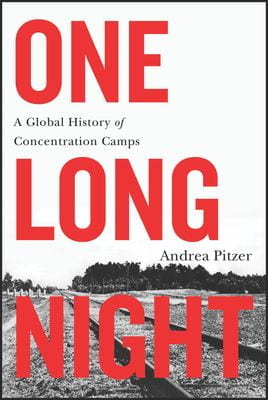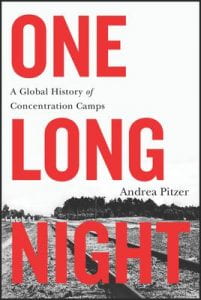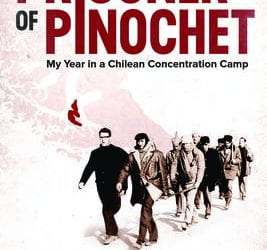A Review of One Long Night: A Global History of Concentration Camps
Latin Roots and Universal Suffering

One Long Night: A Global History of Concentration Camps by Andrea Pitzer New York: Little, Brown and Company, 2017
In One Long Night: A Global History of Concentration Camps, Andrea Pitzer offers a thoughtful combination of investigative journalism and historical analysis that identifies the roots and commonalities across global iterations of concentration camps throughout the 20th century. The book lends poignant testimony to what it means for private citizens to be corralled time and again into spaces where human rights, legal processes and social relations dissolve. Claiming witness to the multiple—and multiplying—systematized instances of removal of human beings from their homes, and demanding accountability from the nations that have hosted the torturous machinations of the ensuing captivities, Pitzer diagnoses the past century as “the lost century.”
Beginning in 1890s, Cuba and later the U.S. control of the Philippines after the Spanish-American War, extending of course to Nazi Europe and Soviet Russia of World War II, Communist China of the 1960s and ’70s, and the Southern Cone of Latin America during the Cold War, the book concludes finally in our current 21st century with a searing condemnation of North Korean prisons alongside ongoing U.S. use of Guantánamo Bay. Invoking Elie Wiesel’s harrowing testimony of the Holocaust, “Never shall I forget that night, the first night in the camp, that turned my life into one long night seven times sealed,” alongside Primo Levi’s assessment that the Shoah was not a singular occurrence, “It can happen, and it can happen everywhere,” Andrea Pitzer upholds the moral imperative to remember the Holocaust in its specific manifestations while also remaining aware and responsible to the concentration camp phenomenon writ large.
Through extensive interviews of historians, activists, soldiers and lawyers, as well as accounts by survivors and camp guards alike, Pitzer demands that her audience reckon with the immoral and often illegal tactics that modern regimes have repeatedly adopted in service of civil wars. These are tactics of inhumanity that steadily exclude “the other” not only from participation in polity or society, but from a collective consciousness. To her study of the emergence and functioning of camps, Pitzer then adds the complicated aftermath whereby survivors and perpetrators again live together in societies once defined by the violent separation and abuse of the former by the latter.
Pitzer’s journalistic fire is balanced by a grounded historical inclination, one that impels her to begin her book by tracing the reconcentración of indigenous Americans by Columbus, a pattern continued through the Spanish and Portuguese conquests to the south and the British and French conquests to the north. Subsequently describing the period of post-independence in the United States, Pitzer notes that the Lieber Code of Conduct, which gave Civil War generals the right to remove all suspected sympathizers from their homes, set an important precedent within U.S. and international law courts—including The Hague in 1899 and the Second Geneva Convention in 1906—one that lent the American Civil War some of its most devastating aspects, and which was instructional for the mass deportations and detentions of Nazi Germany. Pitzer thus demonstrates that as instrumental as bureaucratic efficiencies such as census taking and the invention of barbed wire and automatic weapons were to creating the infamous camps that would mark the 20th century, so too were the historical precedents that paved way for each subsequent iteration.
Providing a clear moral judgment in the context of the first concentration camp studied in the work—the case of Cuba in the wake of its independence from Spain—Pitzer notes: “History is full of moments in which hindsight provides the only clear view. This is not one of them” (20). The author explores the deliberate tactics of cleansing the Cuban countryside of its inhabitants through a policy enunciated on October 21, 1896, summarily accomplished within only two weeks, and describes the Spanish agenda to ensure control of the island as the European country tried desperately to maintain its final foothold in the Americas. The very pursuit of such terrorizing practices influenced U.S. involvement in the war in defense of Cuba—an involvement as much pursued for U.S. political and economic interest and popularized at home in defense of human rights. Pitzer then shows how similar concentration camp tactics were imposed by U.S. troops in the Philippines. Thus, the same war that marked the finality of Spain’s overseas empire transformed the United States from a past colony to an imperial power that adopted the repressive policies of its vanquished foe. Pitzer’s global history of concentration camps, from its inception, thereby demands that the United States confront its own checkered past as it consolidated a national identity through “reconcentrations,” civil war and imperial ambitions, all in preparation to become a global power of the 20th century.
While the book traces many important connections across the globe, I would like to focus on the section covering Latin American concentration camps of the military dictatorships of Chile (1973-1990) and Argentina (1976-1983). In the chapter titled “Bastard Children of the Camps,” Pitzer describes how national public spaces such as sports stadiums were converted into concentration camps: “Agüero headed from the gallery to the closest entrance gate and waited for the guard to let him through. Stepping onto the track he had run as a child, he walked the straightaway and the curve as he circled the soccer field. At his assigned spot he stood waiting for his torturers, taking in the grass, the sky, and tens of thousands if seats, row after empty row” (333). On the same landscape of his childhood, Agüero now faced the embodiment of “atomized terror:” “Illegal detention, it turned out, could be tucked away in the every day world, carried out with few people being the wiser” (354). Through such testimony, the reader witnesses the appropriation of public spaces in service of the dissolution of democracy: “friends pretended to be strangers to protect themselves and each other” (329). These spaces of terror, claims Pitzer, were the “illegitimate offspring of Western democracies,” since the dictatorships of the Southern Cone were supported in secret by the United States as part and parcel of the Cold War within the Global South, including in the case of Latin America, the Guatemalan and Paraguayan coups of 1954, Brazil in the 1960s and Chile and Argentina in the 1970s and ‘80s.
In the example of Felipe Agüero, a victim of Pinochet’s coup in 1973 Chile, Pitzer observes that he tried as much as possible to maintain a notion of humanity not defined in terms set by his captors. Thus, instead of stealing a glimpse of his torturers when he had a chance, Agüero opted to turn away, “frightened to see the face of someone willing to do these things to him” (336). Pitzer thus lends testimony to the determination of the detained to resist the forces and justifications of inhumanity enacted on them. While describing the historical precedents to these camps, as well as the international coordination that at times was instrumental to their existence, Pitzer additionally notes that victims of concentration camps too carried in their minds global and historical frameworks for understanding their own circumstances. In Agüero’s words: “the prisoners, looking at the ground and covered with blankets, appeared markedly worse than any prisoners he had seen thus far. Their shattered aspects brought to mind images of Nazi camp survivors. He wondered where these people had been and what they had gone through to look like that” (339).
In my own research, I have studied subversive culture created by women of the Southern Cone who have urged the importance of post-Holocaust collective memory in bringing reckoning—if not justice—to the humanitarian abuses enacted in their own lifetimes. Creating subversive journalism and theater, producing novels and poetry, women of Argentina and Chile have dialogued with the ghosts of the Holocaust to bring truth to the horrors of their own lifetimes, experienced a generation and ocean apart. As Pitzer outlines the multi-generational and international aspects of the camps themselves, so too has a cadre of Latin American feminist figures emerged to emphasize the multi-directionality of culture in bringing an end to the global proliferation of camps and their goals of genocide.
Recalling Hannah Arendt’s now famous phrase “banality of evil,” which emerged in relation to Eichmann’s trial in Jerusalem, Pitzer outlines the repeated instances in which people around the world have been removed from their homes and treated “as if they no longer existed, as if what happened to them were no longer of interest to anybody, as if they were already dead and some evil spirit gone mad were amusing himself by stopping them for a while between life and death” (7). And yet, Pitzer shows that prisoners or detainees of the multiple camps of the last century have fiercely struggled to maintain their own humanity even while experiencing systematized machinations of de-humanization. Pitzer’s work implores of the current generation: How will the 21st century be defined?
Orígenes latinoamericanos y el sufrimiento universal
Reseña de Dalia Wassner

Una Noche Larga: Una historia global de los campos de concentración por Andrea Pitzer (Nueva York: Little, Brown and Company, 2017)
Una Noche Larga: Una historia global de los campos de concentración, por Andrea Pitzer presenta una combinación reflexiva del periodismo de investigación y análisis histórico que identifica las raíces y los puntos comunes dentro de las reiteraciones mundiales de los campos de concentración a lo largo del siglo XX. El libro brinda un testimonio conmovedor de lo que significa para los ciudadanos privados ser acorralados una y otra vez en espacios restrictivos donde los derechos humanos, los procesos legales y las relaciones sociales se desvanecen. Al atestiguar a las múltiples y sistematizadas instancias de retiro de seres humanos de sus hogares, y exigir la rendición de cuentas de las naciones que han organizado las tortuosas maquinaciones de las captividades subsiguientes, Pitzer diagnostica el siglo pasado como “el siglo perdido.”
Empezando en 1890, el libro traza el surgimiento y desarrollo de los campos de concentración desde una Cuba en anticipación a su independencia, siguiendo con el control estadounidense de las Filipinas después de la Guerra Hispanoamericana, extendiéndose por supuesto a la Europa Nazi y la Rusia Soviética de la Segunda Guerra Mundial, a la China comunista de los años 60 y 70, y al Cono Sur de América Latina durante la Guerra Fría. El libro concluye finalmente en el siglo actual con una fuerte condena de las prisiones de Corea del Norte así como del uso continuo de la Bahía de Guantánamo por parte de los Estados Unidos. Invocando el angustioso testimonio de Elie Wiesel sobre el Holocausto, “Nunca olvidaré esa noche, la primera noche en el campamento, que convirtió mi vida en una larga noche siete veces sellada”, junto con las palabras de Primo Levi que reflexionan que la Shoá no fue un acontecimiento singular, “Puede suceder, y puede suceder en todas partes”, Andrea Pitzer defiende el imperativo moral de recordar el Holocausto en sus manifestaciones específicas y al mismo tiempo permanecer conscientes y responsables ante el fenómeno de los campos de concentración en sus varias manifestaciones.
A través de extensas entrevistas con historiadores, activistas, soldados y abogados, así como de relatos de sobrevivientes y guardias de campos de concentración, Pitzer exige a su audiencia refleccionar sobre las tácticas inmorales y a menudo ilegales que los regímenes modernos han adoptado repetidamente como parte íntegra de guerras civiles. Asi es que Pitzer resalta las tácticas de inhumanidad que constantemente excluyen “al otro” no solo de una participación en la política o la sociedad, sino también de una conciencia colectiva. A su estudio del surgimiento y el funcionamiento de los campos, Pitzer agrega las complicadas secuelas por las cuales los sobrevivientes y perpetradores nuevamente viven juntos dentro de sociedades anteriormente definidas por la separación violenta que resulta en el abuso de los sobrevivientes por parte de los perpetradores.
La pasión periodística de Pitzer la complementa una inclinación histórica arraigada, que la impulsa a comenzar su libro trazando la reconcentración de los indígenas americanos por Colón, identificando así un patrón que continúa a través de las conquistas españolas y portuguesas en el sur y las conquistas británicas y francesas en el norte del continente americano. Describiendo un período posterior a la de la independencia estadounidense, Pitzer señala el Código de Conducta de Lieber, que otorgó a los generales de la Guerra Civil el derecho de remover de sus hogares a todos los sospechosos de simpatizar con los enemigos del norte del país, sentando así un importante precedente dentro de los tribunales de ese país así como dentro de los internacionales, incluyendo La Haya en 1899 y la Segunda Convención de Ginebra en 1906, un precedente que no solamente reflejo algunos de los aspectos más devastadores de la Guerra Civil estadounidense, sino que a la vez fue instructiva para las deportaciones y detenciones masivas de casos posteriores, incluyendo la de los judíos en la Alemania nazi. Pitzer igualmente demuestra como la eficiencia burocrática, así como el surgimiento del censo, la invención del alambre de púas, y las armas automáticas, sirvieron como precedentes históricos para cada iteración posterior del remuevo de ciertas poblaciones dentro de una sociedad.
Proporcionando un juicio moral desde el primer campo de concentración estudiado en la obra—el caso de Cuba al borde de su independencia de España—Pitzer señala: “La historia está llena de momentos en los cuales la retrospectiva proporciona la única visión clara. Este no es uno de ellos “(20). En el contexto cubano, la autora describe una deliberada táctica española anunciada el 21 de octubre de 1896, diseñada para asegurar el control de la isla mientras el país europeo intentaba desesperadamente mantener su última colonia en las Américas, la cual implicó “limpiar” el campo cubano de las poblaciones locales. Esta misma práctica de terror influyó la participación de los Estados Unidos en la guerra en defensa de Cuba, una participación perseguida tanto por los intereses políticos y económicos de los Estados Unidos pero popularizada en defensa de estos violados derechos humanos. No obstante, Pitzer muestra cómo tácticas similares de campos de concentración fueron hipócritamente impuestas por las tropas estadounidenses en las Filipinas en el contexto asiático. Por lo tanto, la misma guerra que marcó la finalidad del imperio Español transformó a los Estados Unidos, una ex-colonia, por primera vez en una potencia imperial que en el paso adoptó las mismas políticas represivas de su enemigo vencido. La historia global de los campos de concentración de Pitzer, asimismo exige que Estados Unidos confronte su propio pasado complicado ya que el país consolidó una identidad nacional a través de “reconcentraciones,” una guerra civil, y ambiciones imperiales, mientras perseguía sus ambiciones de definirse como una potencia mundial del siglo XX.
Si bien el libro rastrea muchas conexiones importantes a lo largo de la historia mundial del siglo XX, me gustaría centrarme en la sección que abarca los campos de concentración latinoamericanos de las dictaduras militares de Chile (1973-1990) y Argentina (1976-1983). En el capítulo titulado “Niños bastardos de los campos,” Pitzer describe la manera en la cual los espacios públicos nacionales como los estadios deportivos se convirtieron en campos de concentración: “Agüero se dirigió desde la galería hasta la puerta de entrada más cercana y esperó a que el guardia lo dejara pasar. Al pisar la misma pista que había corrido de niño, caminó por las partes rectas y curvadas del campo de fútbol. En su lugar asignado se quedó esperando a sus torturadores, percibiendo la sensación del césped, del cielo, y de las decenas de miles de los asientos, fila tras fila ahora vacía “(333). En el mismo paisaje de su infancia, Agüero se enfrenta a lo que se define como “terror atomizado”: “Resultó ser que la detención ilegal podría ser escondida dentro del mismo mundo cotidiano, llevada a cabo con poca gente enterándose” (354). A través de tal testimonio, el lector presencia la apropiación de los espacios públicos en función a la disolución de la democracia: “los amigos fingieron ser extraños para protegerse a sí mismos y protegerse unos a los otros” (329). Estos espacios de terror, afirma Pitzer, fueron “descendientes ilegítimos de las democracias occidentales,” ya que las dictaduras del cono sur fueron apoyadas en secreto por los Estados Unidos como parte integral de la guerra fría a través del sur global, incluyendo en el caso de Latinoamérica, los golpes de estado guatemaltecos y paraguayos de 1954, Brasil en los años 60 y Chile y Argentina en los años 70 y 80 del siglo XX.
En el ejemplo de Felipe Agüero, víctima del golpe de estado llevado a cabo por Pinochet en Chile en 1973, Pitzer refleja que Agüero intentó lo más posible mantener una noción de humanidad que no fuera definida en los términos establecidos por sus captores. Por lo tanto, en lugar de echar un vistazo a sus torturadores cuando surgió la oportunidad, Agüero optó por mirar a un lado, “asustado de ver el rostro de alguien dispuesto a hacerle estas cosas” (336). Pitzer así sirve de testigo a la determinación de los detenidos en resistir las fuerzas y justificaciones de la inhumanidad que se les impone. Al describir los precedentes históricos de estos campos, así como la coordinación internacional que a veces fue decisiva para su existencia, Pitzer señala además que las víctimas de los campos de concentración también tenían en mente marcos globales e históricos para comprender sus propias circunstancias. En palabras de Agüero: “los prisioneros, mirando al suelo y cubiertos con mantas, parecían notablemente peor que cualquier prisionero que había visto hasta ahora. Sus aspectos destrozados trajeron a la mente las imágenes de los sobrevivientes de los campos nazis. Se preguntó dónde habían estado estas personas y qué habían pasado para verse así “(339).
En mis propias investigaciones, he estudiado la cultura subversiva creada por las mujeres del cono sur de latinoamérica, quienes han insistido en la importancia de la memoria colectiva aportando específicamente un marco histórico consciente de las lecciones del Holocausto. Resaltando aspectos comunes en los abusos humanitarios cometidos en sus propias vidas en el contexto latinoamericano, este cohorte de mujeres han aportando al periodismo y teatro subversivo, a las novelas y la poesía, a través de las cuales mujeres Argentinas y Chilenas, durante y posterior a las dictaduras mencionadas, han dialogado con los fantasmas del Holocausto en una generación y un continente aparte. Así es que mientras Pitzer describe los aspectos multigeneracionales e internacionales de los campamentos, a la vez ha surgido un cohorte de figuras feministas latinoamericanas que enfatizan por su lado la posibilidad multidireccional de la cultura en exigir el fin a la proliferación global de campamentos y a sus objetivos de genocidio.
Recordando la ahora famosa frase “banalidad del mal” de Hannah Arendt, frase que surgió en relación al juicio de Eichmann en Jerusalén, Pitzer describe las repetidas instancias en las cuales personas de todo el mundo han sido removidas de sus hogares y tratadas “como si ya no existieran, como si lo que les sucedió ya no les interesaba a nadie, como si ya estuvieran muertos y algún espíritu malvado enloquecido se estuviera divirtiendo deteniéndolos por un tiempo entre la vida y la muerte” (7). Sin embargo, Pitzer muestra que los prisioneros o detenidos de los múltiples campos del último siglo han luchado ferozmente por mantener su propia humanidad incluso mientras sufren las maquinaciones sistematizadas de deshumanización. El libro de Pitzer en última instancia implora a la generación actual: ¿cómo se definirá el siglo XXI?
Fall 2018, Volume XVIII, Number 1
Dalia Wassner, Ph.D. is a Research Associate and the Director of the Project on Latin American Jewish & Gender Studies at the Hadassah-Brandeis Institute of Brandeis University.
Dalia Wassner, Ph.D. es investigadora en el Hadassah-Brandeis Institute de Brandeis University, donde dirije el HBI Project in Latin American Jewish & Gender Studies.
Related Articles
Words that Matter
Those of us with little children often read The Lorax by Dr. Seuss to them at bedtime. The story points toward the past, because the Lorax is a ruin, with only residues remaining of something…
Prisoner of Pinochet: My Year in a Chilean Concentration Camp
English + Español
On September 11, 1973, at about eight o’clock in the morning, Sergio Bitar, one of Allende’s top economic advisers and the Minister of Mining, received a phone call from a colleague: the
The Brave New World of the Digital Herbarium
Here in the northeast of the United States, spring will soon be upon us, pulling us from the darkness and cold of winter’s grip. Spring’s exuberance—singing and nesting birds returning from




